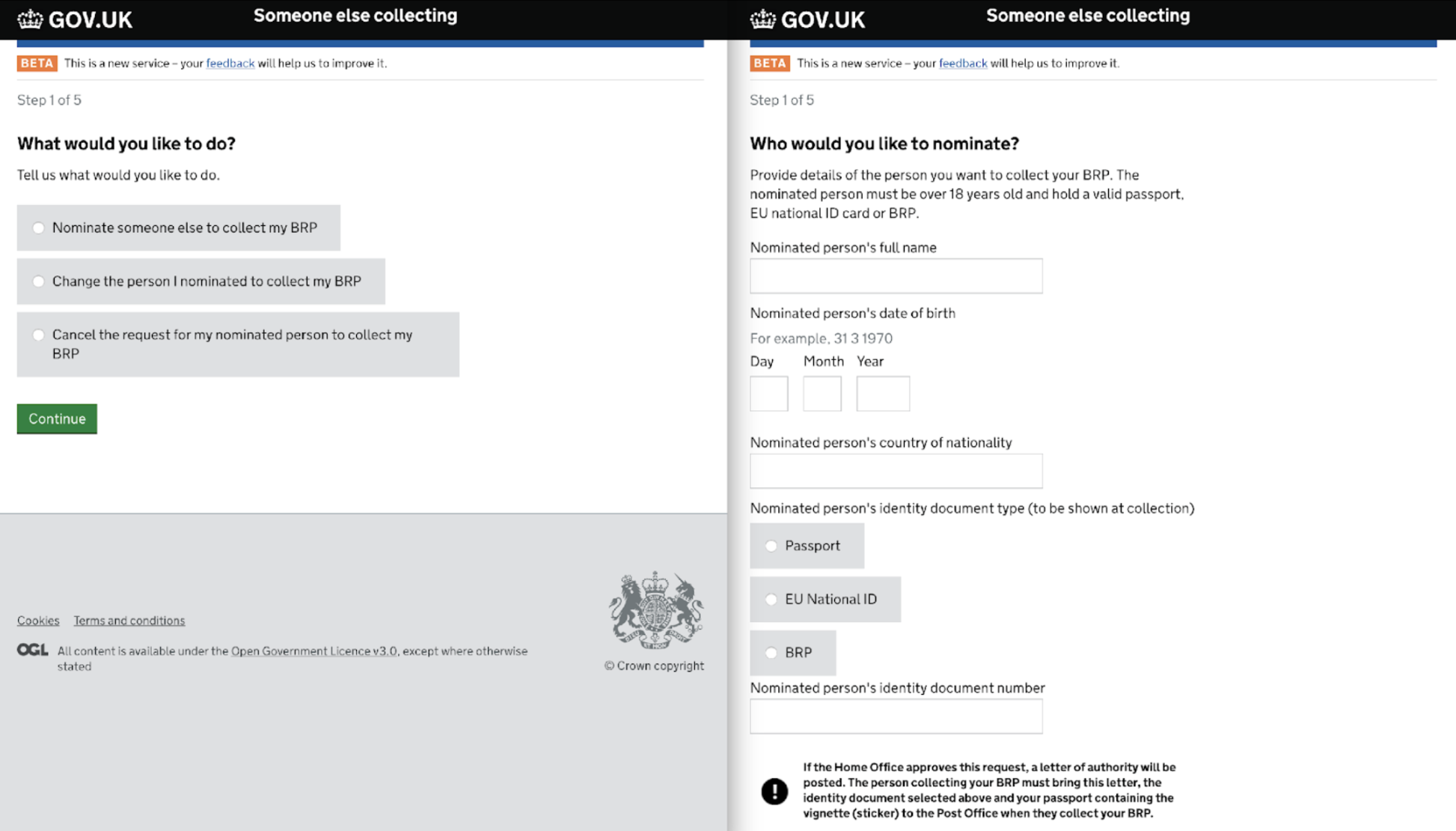The Home Office's Biometric Residents Permit (BRP) enquiry service had twice failed its Beta service assessment. We were tasked to help overhaul the struggling service and get it up to standard.
Biometric residence permits (BRPs) are issued to non-british citizens by the UK Home Office to confirm their status and entitlements while in the UK. They're critical documents, providing proof of identity and a right to study and access to public services.
The Home Office was receiving over 100 thousand enquiries per year reporting problems with BRPs over email, phone and post channels. Often with important information missing. This resulted in repeated contact and delays - a bad experience for the user and inefficient for the service provider. To combat this, the Home Office created an online BRP Enquiries service, enabling users to get help quickly and easily for any BRP issues, such as it being lost or stolen.
The service failed two Beta service assessments against the government’s digital service standard. The assessors explained in their report that whilst the team had a good understanding of how the operational team ran the service, they knew very little about what users needed to successfully use it. The assessors also challenged the decision to use proprietary software, which goes against government guidelines to use open source software.
The client was understandably frustrated, so brought us in to get the service past its beta reassessment.
To better understand the current state-of-play of the service and the challenges it was facing, our initial investigations included:
The first challenge was addressing assessors’ concerns about the lack of user research. We needed to identify and test with real users of the service so that our findings would be truly valid. Initial findings from stakeholder and user interviews enabled us to generate user personas and segmentation maps to ensure we were covering all user groups.
To find the right people, we:
In addition, we identified vulnerable user groups such as asylum seekers, refugees and young people, and those who support them to communicate with the Home Office about issues with their BRP.
We engaged with these users throughout the Beta with interviews and prototype testing sessions. We used findings from these research sessions to develop recommendations to be refined and prioritised for ongoing prototype testing.

Through our testing, we confirmed that a section of the user base had lower digital skills or couldn’t easily access the internet. To best serve these users, we ensured we followed WCAG 2.1 AA accessibility guidelines and conducted accessibility testing throughout.
We conducted extensive cross-browser testing on desktop and mobile devices using screen readers, magnifiers and built in voice controls to evaluate interface components, and ensure the service worked for everyone. We developed and tested an accessible country selector that enabled screen reader users to complete the form in just five minutes.
Lastly, we proposed an alternative telephone-based solution for people in these circumstances. We also provided clear signposting from Visa decision letters and designed the telephone support model.
Upon joining the project, we conducted a technical review of the service requirements and analysed the existing software in use across the Home Office. We identified progress made on open-source libraries by the Passport Office and performed a spike to evaluate the feasibility of reusing these libraries within a central framework. The findings from this investigation informed the development of the service, addressing the panel’s concerns regarding the reliance on proprietary software in the previous solution.
By building the new service with open-source technologies, the department avoided being locked into costly supplier contracts. We implemented a cloud-native, containerised microservices architecture, delivering a flexible, high-performing and secure solution.
We developed all of this using a process of continuous testing and deployment. By making releases and improvements to the software quickly, easily and regularly, we were responsive to changes in business and end user needs. For instance, during busy periods, we could quickly update the service’s response times so caseworkers weren’t overburdened with queries and user expectations were better managed.
The service passed on our first Beta assessment, and subsequent Live assessment, validating that our approach fully aligned with GDS standards. It was also fully GDPR-compliant, as we ensured only necessary personal information was shared securely with UKVI caseworkers in order to allow the processing of the user’s enquiry.
By taking a user centred approach, validating the design of the service through continuous user research, and making the forms accessible and easy to use, the new service achieved 95% digital uptake.
The improved service also provided more detailed and actionable management information to support senior decision-making within the unit. Supplying monthly reports detailing service capability and KPIs to support knowledge transfer.
Finally, the accessible country selector we developed is now being used by numerous other services and departments, allowing them to benefit from the work we delivered.
As our Chief Research Officer Aspasia Dellaporta summarised, "supporting the Home Office in refining this service was a pivotal opportunity - delivering a vastly improved experience for over 120,000 users annually."
“This is an important service with international exposure. The team has embraced the difficult recommendations set out in the original beta assessment. They've demonstrated that it’s possible to successfully challenge the status quo and create a high quality digital service that meets user needs.” Service assessor, Home Office
Following the initial engagement, we provided live support (Level 3) to the services for over 2 years.
After many years of delivering a successful service, the Home Office will soon be retiring the service, as BRPs are being replaced by eVisas.
Whether you’re ready to start your project now or you just want to talk things through, we’d love to hear from you.